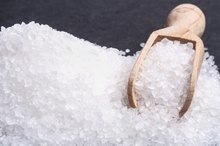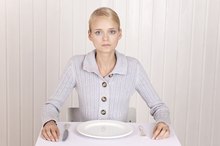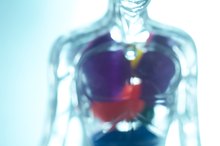What does fact checked mean?
At Healthfully, we strive to deliver objective content that is accurate and up-to-date. Our team periodically reviews articles in order to ensure content quality. The sources cited below consist of evidence from peer-reviewed journals, prominent medical organizations, academic associations, and government data.
The information contained on this site is for informational purposes only, and should not be used as a substitute for the advice of a professional health care provider. Please check with the appropriate physician regarding health questions and concerns. Although we strive to deliver accurate and up-to-date information, no guarantee to that effect is made.
Primary Biliary Cirrhosis Diet
Usually diagnosed before symptoms occur, primary biliary cirrhosis, or PBC, is a chronic medical condition that causes inflammation and damage to the bile ducts in the liver 2. This causes scarring and may ultimately lead to cirrhosis. The diet for people with PBC is aimed at promoting health and meeting nutrient needs. A healthy balanced diet that supplies enough calories and protein is recommended, but diet modifications may be necessary if complications, such as ascites, occur 3.
Diet Basics
A healthy balanced diet for PBC includes a variety of foods from all the food groups 3. The British Liver Trust suggests that you fill your diet with fruits and vegetables, with a goal of five servings a day. For protein, include:
- lean sources of meat
- poultry
- seafood
- eggs
- beans
Include low-fat or nonfat dairy foods for bone health and to keep a lid on fat.
Watch Your Sodium
What Are the Causes of Stomach Edema?
Learn More
Ascites, which is a complication related to PBC, causes abdominal fluids to build up in your abdominal cavity. If you have fluids in your abdomen, you may need to limit sodium in your diet. You should talk to your doctor about your sodium needs, but sodium is generally restricted to 2,000 milligrams a day. You can reduce sodium intake by not adding salt to your food and limiting your consumption of processed foods such as deli meat, frozen meals, canned foods and boxed mixes. Also, read labels and look for foods that contain 140 milligrams of sodium or less.
- Ascites, which is a complication related to PBC, causes abdominal fluids to build up in your abdominal cavity.
- You should talk to your doctor about your sodium needs, but sodium is generally restricted to 2,000 milligrams a day.
Meals for PBC
A healthy meal plan should include three meals containing about the same amount of food and one snack. A healthy breakfast that is balanced and low in sodium might include a bowl of oatmeal with raisins and sliced almonds, a cup of nonfat milk and a banana. For lunch, you might enjoy grilled chicken on a whole-wheat roll, along with mixed greens topped with balsamic vinegar and oil, and a fresh orange. A healthy dinner for someone with PBC might include broiled tuna steak with a baked potato and steamed carrots. Nonfat yogurt with low-sodium whole-grain crackers makes a healthy snack option.
- A healthy meal plan should include three meals containing about the same amount of food and one snack.
- A healthy breakfast that is balanced and low in sodium might include a bowl of oatmeal with raisins and sliced almonds, a cup of nonfat milk and a banana.
Special Diet Considerations
Diet for Alcoholic Liver Disease
Learn More
Malnutrition is a concern for people with PBC due to changes in appetite, altered metabolism and inadequate absorption of vitamins and minerals. When food intake is poor and nutritional needs are high, a diet that is high in calories and adequate in protein is recommended. High-calorie nutrition shakes may be necessary to help meet needs if appetite is poor. During this stage of the disease, consult with your doctor or a dietitian for suggestions on how to improve nutritional intake.
- Malnutrition is a concern for people with PBC due to changes in appetite, altered metabolism and inadequate absorption of vitamins and minerals.
- High-calorie nutrition shakes may be necessary to help meet needs if appetite is poor.
Related Articles
References
- National Institute of Diabetes and Digestive and Kidney Diseases: Primary Biliary Cirrhosis
- British Liver Trust: Primary Bilary Cirrhosis
- NHS Choices: A Balanced Diet
- Seminars in Liver Disease: The Management of Ascites and Hyponatremia in Cirrhosis
- The Ohio State University Wexner Medical Center: Very Low Sodium (2 Gram) Diet
- Gastroenterology: Nutrition in End-Stage Liver Disease: Principles and Practice
- Bhatia SN, Underhill GH, Zaret KS, Fox IJ. Cell and tissue engineering for liver disease. Sci Transl Med. 2014;6(245):245sr2. doi:10.1126/scitranslmed.3005975
- Bémeur C, Butterworth RF. Nutrition in the Management of Cirrhosis and its Neurological Complications. Journal of Clinical and Experimental Hepatology. 2014;4(2):141-150. doi:10.1016/j.jceh.2013.05.008
- Yao C, Fung J, Chu N, Tan V. Dietary Interventions in Liver Cirrhosis. J Clin Gastroenterol. 2018;52(8):663-673. doi:10.1097/mcg.0000000000001071
- National Institute of Diabetes and Digestive and Kidney Diseases. Eating, Diet, & Nutrition for Cirrhosis. Published March 2018.
- Purnak T, Yilmaz Y. Liver disease and malnutrition. Best Practice & Research Clinical Gastroenterology. 2013;27(4):619-629. doi:10.1016/j.bpg.2013.06.018
- Barnard, Neal D., editor. Cirrhosis. Nutrition Guide for Clinicians, 3rd ed., Physicians Committee for Responsible Medicine, 2017.
- McClain CJ. Nutrition in Patients With Cirrhosis. Gastroenterology & hepatology. 2016;12(8):507-510.
- Angeli P, Bernardi M, Villanueva C, et al. EASL Clinical Practice Guidelines for the management of patients with decompensated cirrhosis. Journal of Hepatology. 2018;69(2):406-460. doi:10.1016/j.jhep.2018.03.024
- Ioannou GN, Morrow OB, Connole ML, Lee SP. Association between dietary nutrient composition and the incidence of cirrhosis or liver cancer in the united states population. Hepatology. 2009;50(1):175-184. doi:10.1002/hep.22941
- U.S. Department of Veterans Affairs. Eating tips for people with cirrhosis.
- Nakaya Y, Okita K, Suzuki K, et al. BCAA-enriched snack improves nutritional state of cirrhosis. Nutrition. 2007;23(2):113-120. doi:10.1016/j.nut.2006.10.008
- Suk KT, Baik SK, Yoon JH, et al. Revision and update on clinical practice guideline for liver cirrhosis. Korean J Hepatol. 2012;18(1):1-21. doi:10.3350/kjhep.2012.18.1.1
- Volk M. Liver cirrhosis: a toolkit for patients. University of Michigan Health System. Updated October 25, 2011.
- Runyon, B. Management of Adult Patients with Ascites Due to Cirrhosis. American Association for the Study of Liver Diseases (AASLD). Updated 2012.
- Runyon BA. Management of adult patients with ascites due to cirrhosis: Update 2012. American Association for the Study of Liver Diseases. 2012.
- Barkoukis H, Fiedler KM, Lerner E. A combined high-fiber, low-glycemic index diet normalizes glucose tolerance and reduces hyperglycemia and hyperinsulinemia in adults with hepatic cirrhosis. J Am Diet Assoc. 2002;102(10):1503-7. doi:10.1016/S0002-8223(02)90334-2
- National Institute of Health. LiverTox: Vitamin A. Updated July 1, 2019.
- Manguso F, D’Ambra G, Menchise A, Sollazzo R, D’Agostino L. Effects of an appropriate oral diet on the nutritional status of patients with HCV-related liver cirrhosis: A prospective study. Clinical Nutrition. 2005;24(5):751-759. doi:10.1016/j.clnu.2005.02.010. doi:10.1016/j.clnu.2005.02.010
Writer Bio
Jill Corleone is a registered dietitian and health coach who has been writing and lecturing on diet and health for more than 15 years. Her work has been featured on the Huffington Post, Diabetes Self-Management and in the book "Noninvasive Mechanical Ventilation," edited by John R. Bach, M.D. Corleone holds a Bachelor of Science in nutrition.








